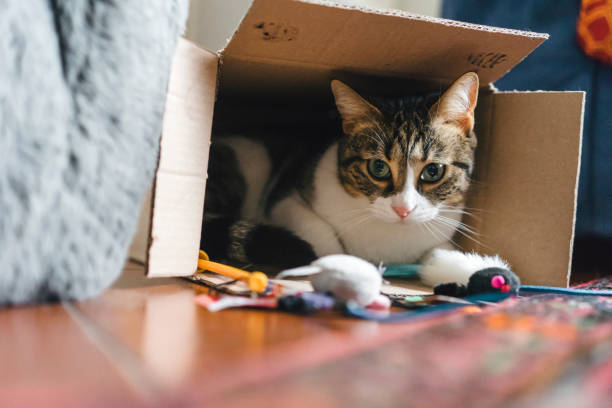Some cats are more shy than others. Quite often, those cats missed early socialization with humans and-or have not been exposed to a variety of different situations.
Those cats lack confidence and have not developed the tools to easily adapt to new situations, such as a new environment.
The shy cat needs :
- To feel at ease in his new surrounding before being able to trust humans
- More time to adapt, which can take weeks, even months
- A calm and stable environment
To ensure a successful adaptation, it is important to follow the rules, and not skip any of the steps. Otherwise, the adaptation time will be longer and more difficult for the cat
1 – Adapting his environment
- A closed and quiet room - far from the hustling of the household
- Place his food and water bowls in a corner of the room and his litter box in the opposite corner
- Provide attractive hiding spots such as cardboard box with woolly blanket, small cat tent, open pet carrier, etc.
- Place the hiding spots in a way that you can have a look inside from a distance, ideally away from the entrance to the room to prevent scaring him and keeping a good distance with you
- Provide the cat with elevated observation points, ideally at a height of at least 1.5 meters
2- Respect his pace
- Frequent visits are in order, while maintaining a certain distance at first
- Use a calm and soft voice to address him
- Sitting down on the floor and respecting is height is advisable
- Do not try to touch or pick up the cat
- The cat will let you know when he is ready to establish contact
- Use food to make your visits a positive experience
- the cat is busy eating in front of you, you may want to take the opportunity to reduce the distance between the cat and you
- Always play while keeping a certain distance. Using a stick, cord and feather at the end is an ideal game for the cat.
How do we know when the cat is ready to establish a contact ?
- It will come out of hiding and be curious
- It will eat the goodies in front of you
- It will keep a ‘high’ posture, i.e. body, head, ears, even its tail.
- It will play in your presence
It is up to the cat to make the first steps towards you, and not the other way around.
3- The power of goodies
- Food is the best incentive we can use for training a cat
- Finding his preferences is a game of trial and errors
- Use goodies every time you pay your cat a visit
- It is possible for your cat to not eat in your presence at first
- The better the goodies, the easier the adaptation will be.
Goodies examples you may wish to try :
- Cheese
- You can find ‘Creamy cat it’ (cats love it !) in an pet store
- Tuna
- Sardine
- Canned cat food.
- ‘Temptation’ or other types of goodies for cats
- Dried fish
Always use small quantities at first, because chances are you will be giving out some more often.
Share!
